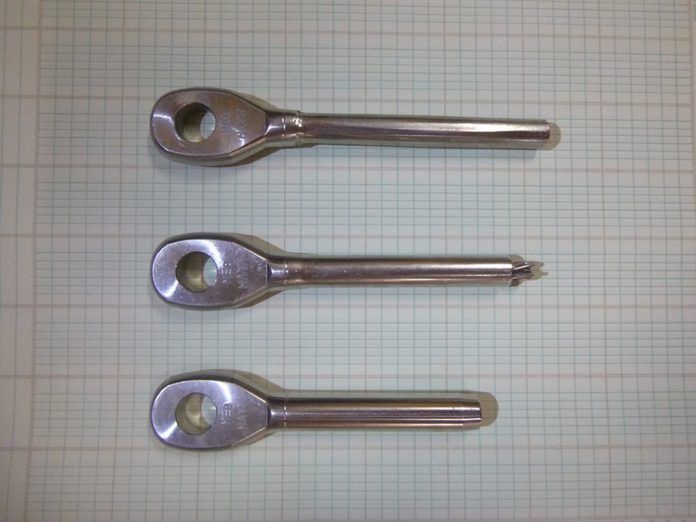Brion Toss

Among the many chores to add to the spring to-do list, a rig inspection should rank high. For sailors in the higher lattitudes who unstep their mast each season, this is the easiest time to inspect stem-ball fittings, tangs, and other mast hardware that is usually inaccessible withouth going aloft.
Last year Port Townsend rigger Brion Toss guided us through the inspection process, highlighting common warning signs. In the upcoming April issue of Practical Sailor, Toss again weighs in on the arts of sailboat rigging with an analysis of mechanical, screw-on terminals from Hi-Mod (Hayn), Sta-Lok, and Norseman. The report, which involved breaking several samples and documenting their failures, is the second part in an ongoing series on rigging. The first part, which included a step-by-step description of assembling a screw-on terminal, appeared in the June 2015 issue of Practical Sailor.
The pull-to-failure tests that Toss carried out for the upcoming issue highlighted another concern that he didnt mention in his rig inspection article-out-of-spec swages. Although corroded or cracked swage fittings have been know to be a common point of failure on older rigs, the environment and working loads are almost always the main contributing factors. But our recent tests suggest that the weaknesses on some terminals may begin on Day One and be the result of flawed swaging tools. It is important to be clear that the swages themselves are not at fault here; it was the process of swaging that apparently contributed to the failure.
For our initial pull tests, the wire rope used for testing (5/16-inch was used for most tests) was fitted with a swaged eye and then broken. The aim of this exercise was to determine a benchmark for the screw-on terminals. However, during the first round of this testing, Toss was surprised to see that wire failures on the newly assembled fittings were occuring at loads that were 10 percent lower than the wires rated tensile strength-and the failures were occuring at or near the swage, suggesting that it had contributed to the failure. This was particularly mysterious, since the swaged-end fittings were applied by a rotary swage machine, considered to be a very reliable way to form swaged terminals.
Only after Toss took calipers to some newly swaged ends did he realize what was causing the failures. The shop hired to do the swaging was using a rotary swage machine that was out of spec. As a result of this experience, Practical Sailor is urging sailors to double check before ordering swaged rigging to ensure the swage machine is in spec, and to confirm that the finished swages are within the specified diameter. To check existing fittings, Ronstan offers guidelines on its website, http://www.ronstan.us/marine5/rigging rollswaging_data.asp. (If you have trouble with the link, try Googling “RonstanRigging Product Roll Swaging Specifications.”)
Keep in mind that most rigging has a high safety factor that will tolerate a 10 percent loss in strength, but as rigging ages, the factors that can contribute to rig failure begin to compound. There is no reason to add out-of-spec swages to the mix. While other industries that use wire rope in structural applications establish specific standards for performance, currently there are no standards in place for boat riggers to follow. Previously, the American Boat and Yacht Council has discussed having such standards and we would encourage them to look into this again. In our view, consumers should be able to know that their rig and its components have been assembled by someone who is properly trained in the art and in a fashion that meets a certain minimum standard.









































P.R.;
Thanks for the article on the entirely too obscure subject of marine terminal swaging.
I recently bought all new standing rigging for my boat and during the process
had occasion to see two swages with some curvature in the shank. This left me unsettled as to why and whether it foreshadowed problems. So I went off on a tear researching online and was surprised to find the subject poorly covered by the sailing community. There is plenty on indicators for old rigging: rust spots cracks etc, and how to’s for mechanical terminals but good discussion on possible defects in new swaging such as modest variations in swage form (lines, ring patterns etc) were rare to say the least. Basically the average sailor buys these things from their rigger on good faith and the assurance those “very expensive” machines do the magical thing and we should not worry. If in fact you know of some good sources on this topic please spread the word, I’d love to be better educated!
Anyway, I think the topic needs much more exposure and “transparency”